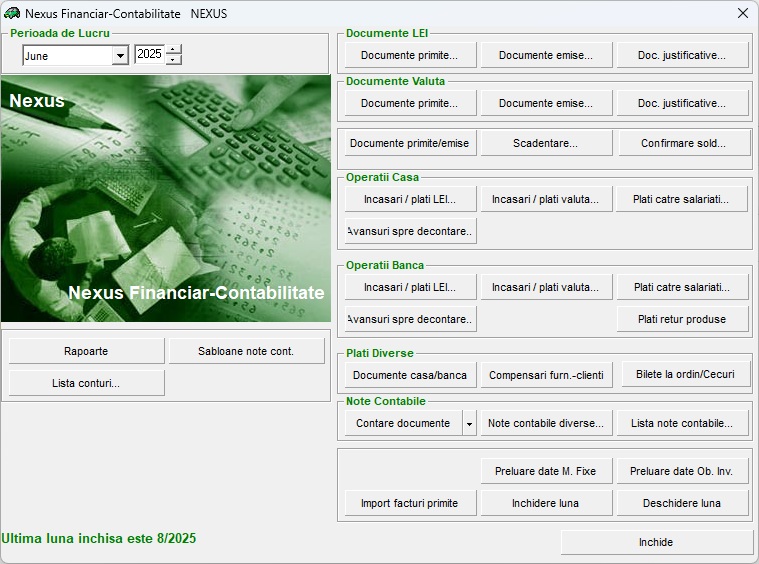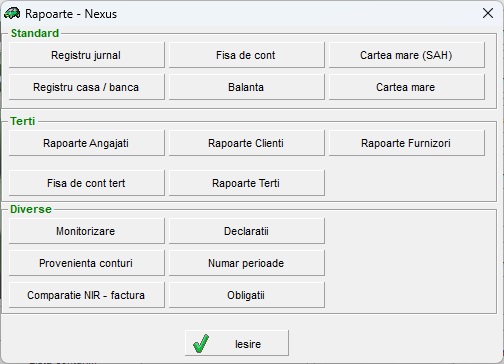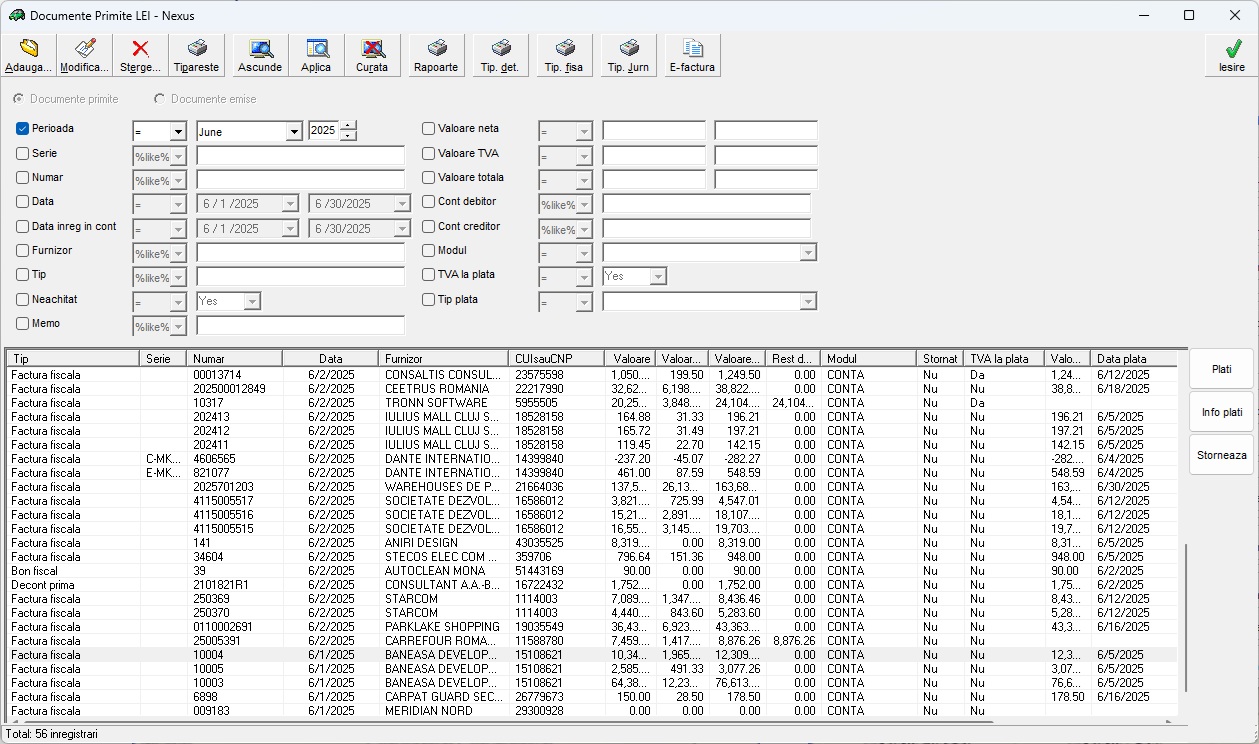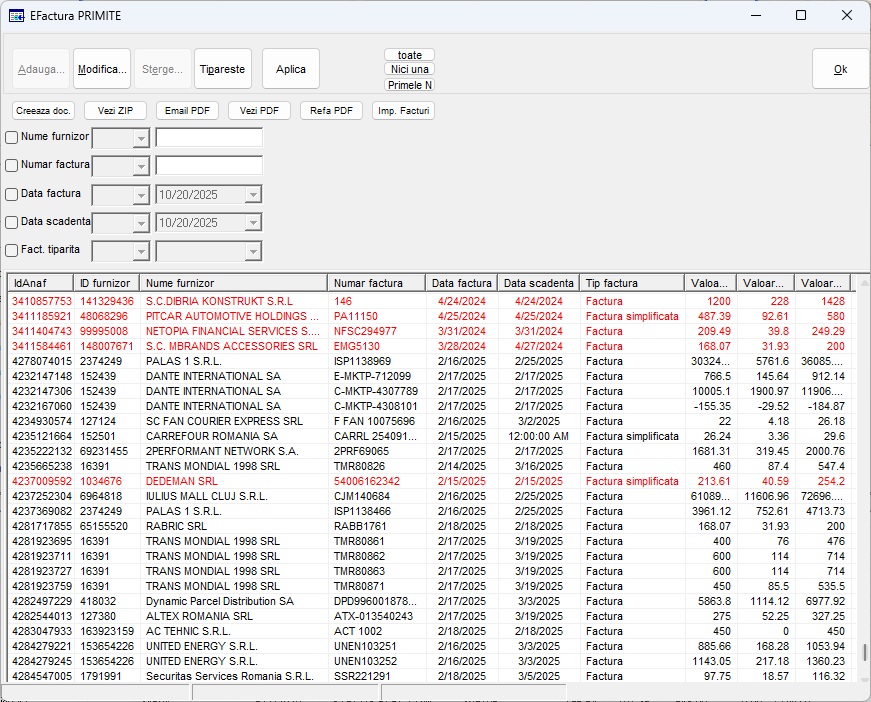Accounting Module
The Accounting module provides complete support for accounting tailored to the Romanian style. It also offers real-time support for automatic accounting based on events that can be defined in other modules, along with the possibility of customizing the financial-accounting effects they produce.

Main Functionalities
- Module Configuration – includes the possibility to define the chart of accounts, the accounting monograph (a list of account correspondences), defining analytical accounts, the way revenue and expense accounts are automatically closed, and VAT settlements, as well as initializing account balances at the beginning of using this module;
- Entering accounting entries; there are several ways to enter accounting entries into the database. These entries can be generated automatically from actions in other system modules or manually entered by the user;
- Predefined accounting operations can be set up, making data entry much easier;
- Automatically generates accounting entries for documents from the Nexus Retail modules (Management, Fixed Assets, Inventory Items, etc.);
- Automatically generates accounting entries for payments and receipts of invoices in RON/foreign currency, calculating currency exchange differences;
- Automatically generates the closing entries for revenue and expense accounts;
- Automatically generates accounting entries for VAT settlements;
- Automatically generates accounting entries for the revaluation of account balances in foreign currencies;
- Automatically generates accounting entries for offsetting transactions;
- Remembers information about the origin of each accounting entry, so that users can view/edit the associated document at any time.
Reports
- Journal Register – lists accounting entries for a given month;
- Account Statement – lists accounting entries for a selected account over a specific month/period;
- General Ledger – this report contains the sum of accounting entries for the selected account and direction, grouped by corresponding accounts and by month, with subtotals for each quarter and a cumulative total for the year;
- General Ledger SAH – a report similar to an account statement, except it prints for multiple accounts at once;
- Cash/Banks Register – lists accounting entries for cash/bank accounts (RON/foreign currency) for a given day/month;
- Trial Balance – includes initial balances, turnovers for the current or selected month, final amounts (at the end of the month/year), and final balances. Several types of trial balances are available;
- Sales Journal – contains the list of all documents issued with VAT;
- Purchases Journal – contains the list of all documents received with VAT;
- Employee Account Statement – similar to the Account Statement report, except all calculations are made for a specific employee. One or more employees can be selected;
- Unpaid Invoices – lists all issued invoices with a balance different from 0 for a given period;
- Unpaid Received Invoices – lists all received invoices with a balance different from 0 for a given period;
- Client Journal – lists all invoices issued for one or more clients, showing detailed information for each document (total invoice amount, paid amount, balance due, etc.);
- Client List;
- Client Account Statement – similar to the Account Statement report, but calculations are made for a specific client. One or more clients can be selected;
- Client Analytical Balance – for a selected account, one or more clients, and a selected period, the following are displayed: beginning balance for the year, total debit turnover, total credit turnover, beginning balance for the month, monthly debit turnover, monthly credit turnover, accounting note number, position number in the accounting note, document number, total document value.
- Client Synthetic Balance – for a selected account, one or more clients, and a selected period, the following are displayed: beginning balance for the year, total debit turnover, total credit turnover, beginning balance for the month, monthly debit turnover, monthly credit turnover, final balance (debit or credit);
- Supplier Journal – lists all invoices received from one or more suppliers, showing detailed information for each document (total invoice amount, paid amount, balance due, etc.);
- Supplier List;
- Supplier Account Statement – similar to the Account Statement report, but calculations are made for a specific supplier. One or more suppliers can be selected;
- Supplier Synthetic Balance – for a selected account, one or more suppliers, and a selected period, the following are displayed: beginning balance for the year, total debit turnover, total credit turnover, beginning balance for the month, monthly debit turnover, monthly credit turnover, final balance (debit or credit);
- Annual Cash Flow – a report that displays the receipts/payments of the company broken down by specific indicators, such as: client receipts, debtor/creditor receipts, bank receipts, supplier payments, salary expenses, material expenses, etc. New indicators can be added or existing ones deleted. Values are displayed for each month of the selected year and are expressed in RON and a selected currency;
- Financial Analysis – Monthly Cash Flow – similar to the “Annual Cash Flow” report, but values are displayed for a selected month;
- Monthly Analysis of Account 121 – lists revenue and expense account balances for a selected month;
- Cumulative Turnover Analysis of Account 121 – lists revenue and expense account balances for a selected month, cumulative with all months prior to the selected month;
- VAT Situation – lists the VAT situation for a specific year, broken down by month, showing: beginning balance, deductible and collected VAT, VAT to be paid and recovered for the month, cumulative VAT to be paid and recovered, and information about the payment documents used for VAT payments/recoveries;
- Cash Flow – for one or more selected cash/bank accounts, for a specific period, it displays the corresponding account, debit/credit turnovers, and debit/credit balances;

Interactions
The Accounting module interacts with the following modules:
- Management: communicates with this module to transmit information about documents issued, which are then automatically imported into accounting. All receipts made in accounting will also be reflected in the Management module.
- Diverse Invoices: communicates with this application to transmit information about documents processed in this module to be automatically posted in accounting.
- Fixed Assets and Salaries: automatically imports accounting entries related to salaries, depreciation, and the removal of fixed assets from management.
Accounting Module

